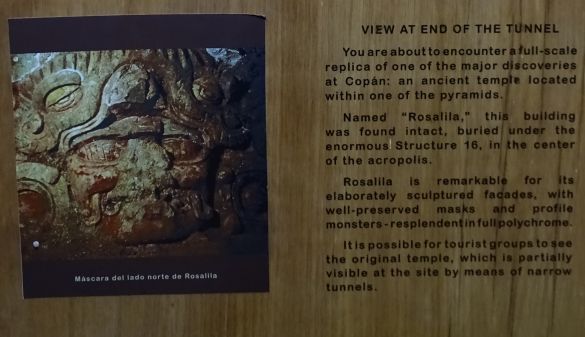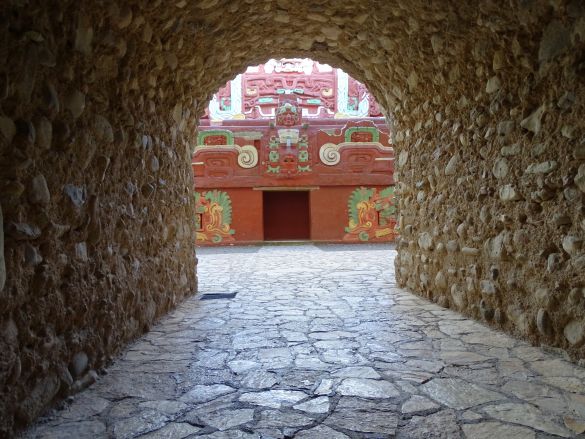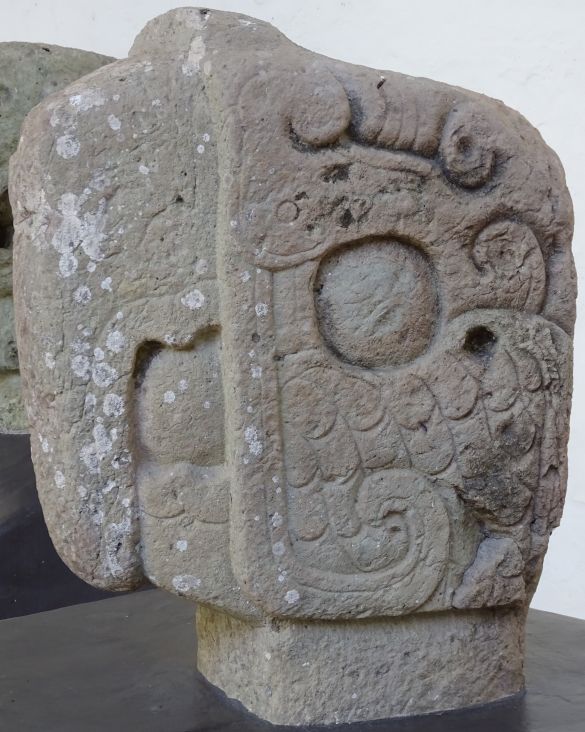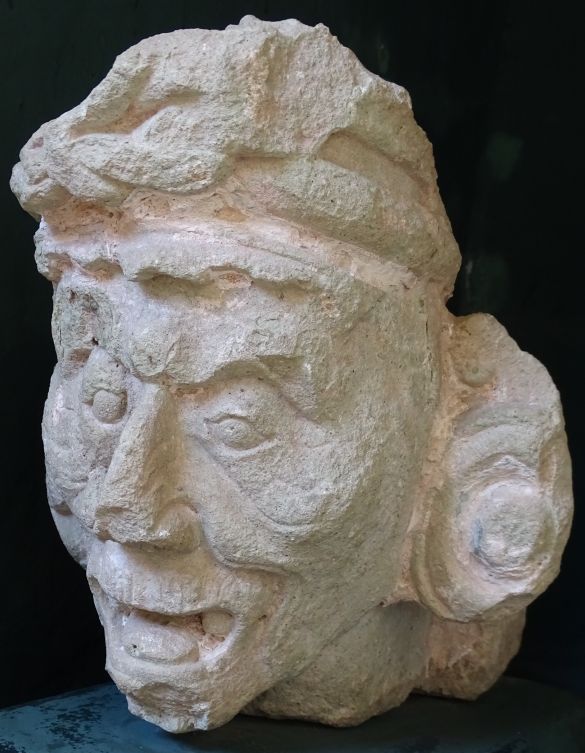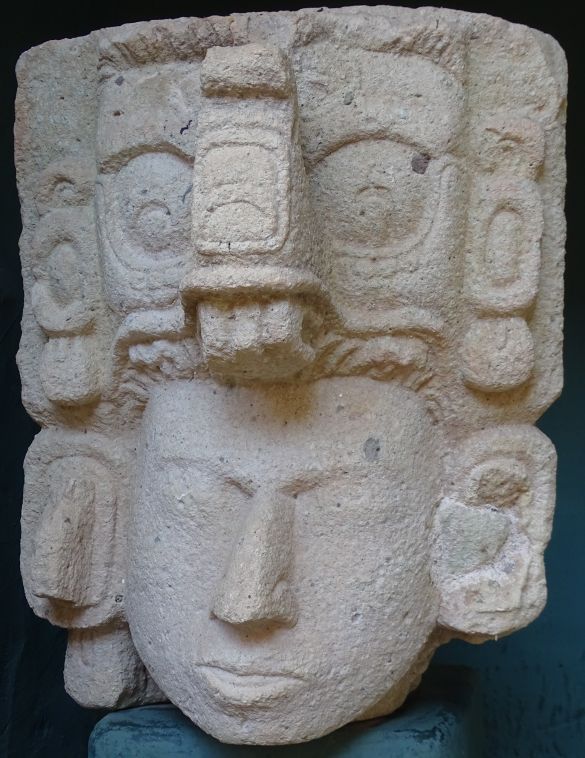In het oude Maya-denken staan tunnels of natuurlijke grotten voor de toegang tot de onderwereld, Xibalba.
De toegang tot een grot kan de symbolische vorm aannemen van een open mond of een slang of een krokodil.
De tunnel die toegang geeft aan het museum (Museo de la Escultura de Copán) is daarom bij de ingang voorzien van een hoofd.
De onderwereld is de plaats waar de doden leven, de voorouders maar ook de afschrikwekkende beesten, de demonen en de goden van de dood.
Hunahpu en Ixbalanqué, de heldentweeling uit de Maya-mythologie, moesten voor de goden van de onderwereld een aantal beproevingen doorstaan voor ze naar de hemel kunnen gaan.
Met bovenstaande tekst (in het Engels) eindigde mijn vorige
bericht over Copán.
De tekst stond te lezen in de tunnel die de toegang tot het museum vormt.
Daar in die tunnel pak ik de draad weer op.
View at the end of the tunnel
You are about to encounter a full-scale replica of one of the major discoveries at Copán: an ancient temple located within one of the pyramids.
Named “Rosalila”, this building was found intact, buried under the enormous Structure 16, in the center of the acropolis.
Rosalila is remarkable for its elaborate sculptured facades, with well-preserved masks and profile monsters – resplendent in full polychrome.
It is possible for tourist groups to see the original temple, which is partially visible at the site by means of narrow tunnels.
Of in het Nederlands:
Zicht aan het einde van de tunnel.
Dadelijk aan het eind van de tunnel ontmoet je de replica op ware grootte
van een van de belangrijkste ontdekkingen in Copán:
een antieke tempel die zich in een van de piramides bevindt.
De tempel wordt “Rosalila” genoemd, het gebouw is intact gevonden
terwijl het begraven ligt onder de enorme ‘Structuur 16’,
in het centrum van de acropolis.
Rosalila is zo bijzonder door de gevels die uitgebreid zijn voorzien van beeldhouwwerk
met goed bewaarde maskers in schitterende veelkleurigheid.
Het is voor groepen bezoekers mogelijk om via smalle tunnels de originele tempel te zien
die deels zichtbaar is in de site.
Dit is dan het beeld als je door de tunnel loopt, het museum in. Het museum bevat heel veel beelden die op de bijbehorende site gevonden zijn. Die beelden zijn gerestaureerd en er zijn replica’s van vervaardigd. Die replica’s zie je op de site, de originelen hier in het museum. Het museum (Museo de la Escultura de Copán) is een soort voetbalveld. Boven de ‘grasmat’ is het plafond open maar de beelden die staan allemaal overkapt.
Hier zie je de overkapping en het open plafond. Het is een prachtig complex.
Dit is een van de decoraties van de Rosalila-replica.
Dit is de helft van de vorige foto om meer details te kunnen tonen. Wat je hier ziet is wat we veel vaker zien: reliëfs. Afbeeldingen die langzaam uit de achtergrond naar voor komen. In de loop van de geschiedenis gaat dat steeds verder en komen de reliëf los van de achtergrond.
Bij Rosalila staat een stele met daarop deze afbeelding. Stele P met de afbeelding van K’ahk’Uti’Chan. Op 21 maart 628 AD is dit beeld ingehuldigd.
Stela P is from the West Court of the Acropolis near the northwest corner of Structure 16.
Carved on the front is a portrait of the 11th ruler K’ahk’ Uti’ Chan, who reigned from AD 578 to AD628.
He is dressed in the royal costume of K’inich Yax K’uk’ Mo’, the first ruler of the Copán dynasty.
The stela’s dedication date is 9.9.10.0.0 2 Ajaw 13 Pop or March 21, AD 623.
It was erected while “Rosalila” was still in use and its placement in the museum is in accord with where it likely stood in front of “Rosalila”.
Je ziet in deze tekst dat men neutrale benamingen
voor de grote bouwwerken kiest.
Zo spreken ze van structuren.
De namen van de heersers zijn voor een leek wel even slikken.
Vreemde klankcombinaties en veel enkele aanhalingstekens.
Er is dus niets mis met mijn typen, dat hoort zo: K’inich Yax K’uk’ Mo’.
Bijzondere datumnotatie: 9.9.10.0.0 2 Ajaw 13 Pop.
Daar zit een hele studie achter.
Museo de la Escultura de Copán.
Dit zijn de koppen van ara’s (papegaaien in het Engels macaw genaamd). Macaw head markers ball court I – II – III.
Nog een voorbeeld.
The Copán ballcourt was rebuilt four times over a span of 300 years, beginning with the first ruler K’inich Yax K’uk Mo’ and ending with the 13th ruler, Waxaklajun Ubaah Káwiil.
Over time the ballcourt ecpanded and moved northward, but the bench markers were always macaw heads.
Displayed here are samples of the bench markers from each phase.
They are a fine example of a changing art style over time.
We may imagine that in the Copán version of the rubber ball game, the player or team who hit one of the bird heads was awarded special significance.
Among the ancient Maya, the scarlet macaw, with its fiery colors, symbolized the sun.
Water bird and streams, gevonden in de Hijole-structuur.
Water Bird and streams, “Hijole”-Structure
In 1987 a buried room and a demolished structure were found inside the northeast corner of the final version of structure 26.
Excavators were so surprised to find an unexpected room with elaborate sculptures buried inside, that the building was named “Hijole” (an exclamation of surprise).
Believed to have once adorned an earlier version of Temple 22, the water bird is awarded the price for the highest relief sculpture found in Copán.
Carved out of one rock, it is an extraordinary example of the nearly full-round quality of the facade sculpture at the height of Ruler 13’s reign.
The chest and belly of the bird take the form of a grotesque head that frequently occurs in Maya art and is sometimes referred to as a “personification head”.
The water streams on either side suggest the natural habitat of the bird.
Museo de la Escultura de Copán.
Museo de la Escultura de Copán.
Museo de la Escultura de Copán.
Museo de la Escultura de Copán.
Copán: Rosalila-replica.
Er gaat nog veel meer volgen!

